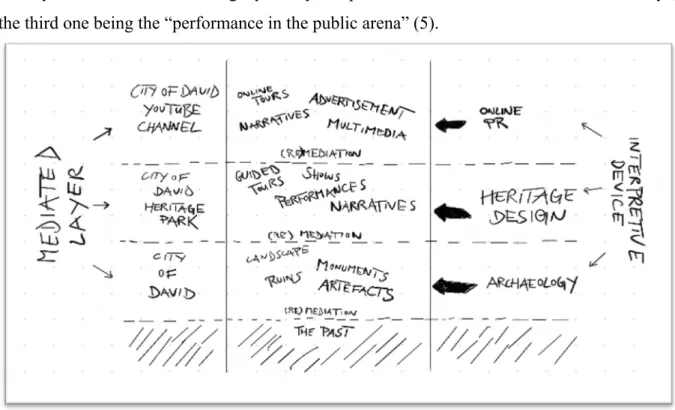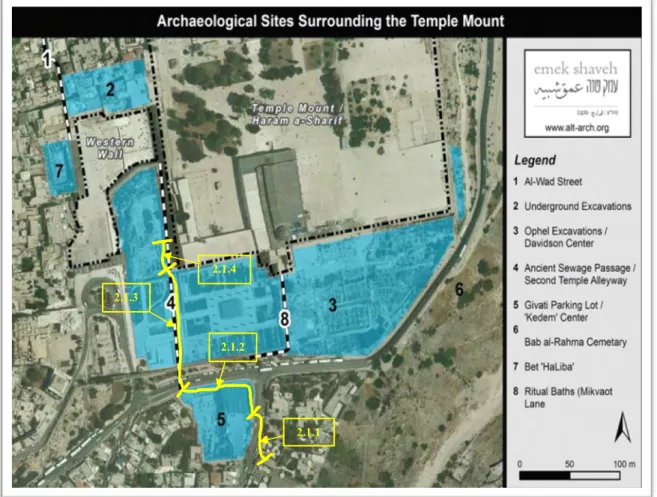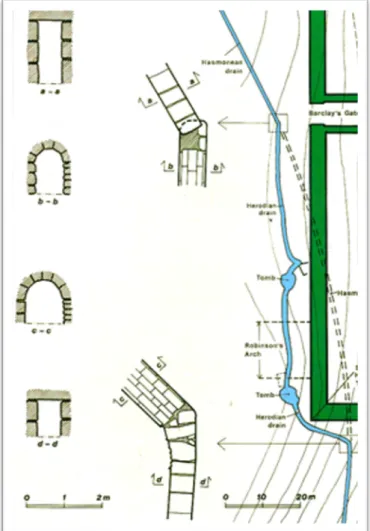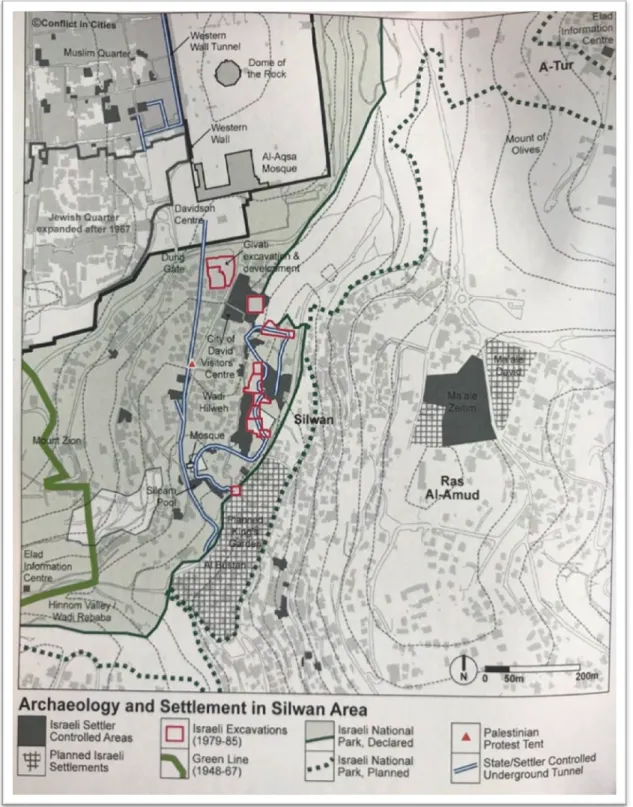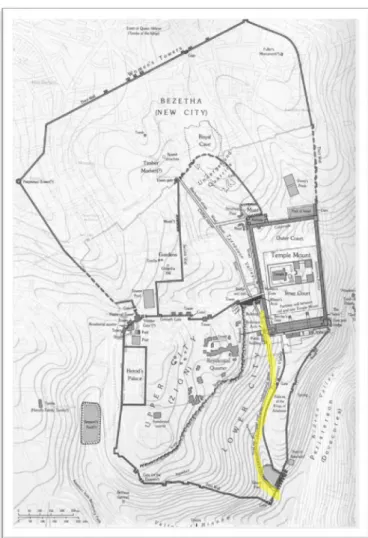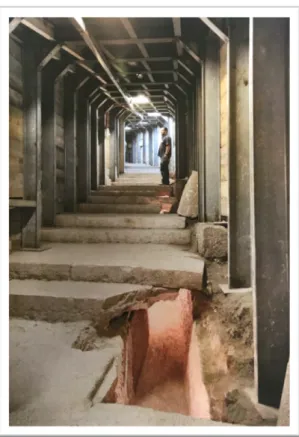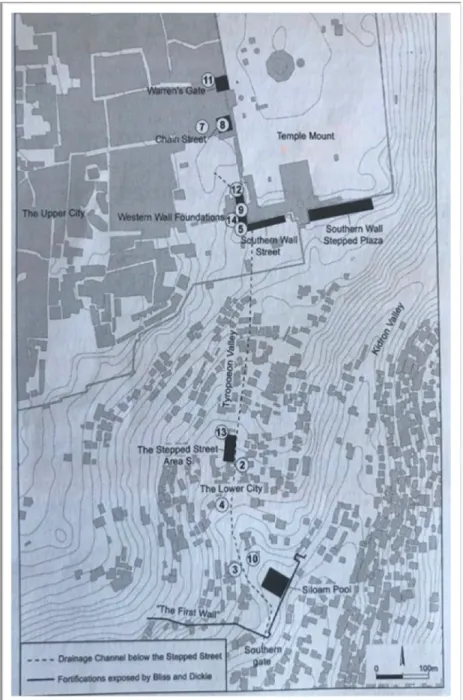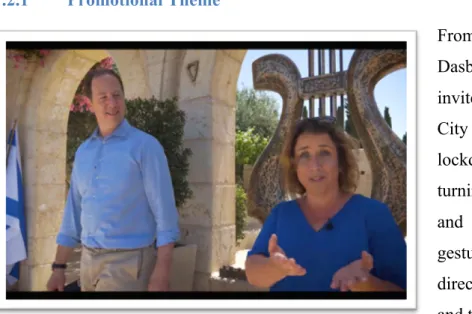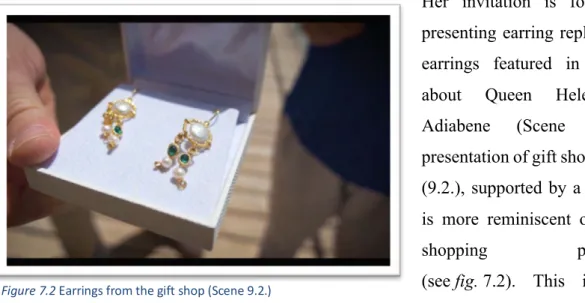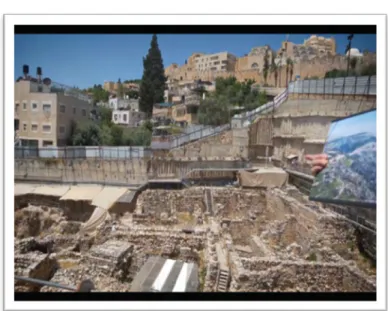“Once They Touch, They Get Connected”
(Re)mediating the Past Through Narratives and Performances on the Pilgrimage Road, in the City of David (East Jerusalem)
Fridtjof Leemhuis
Supervisor
Professor Kristin Bliksrud Aavitsland
MF Norwegian School of Theology, Religion and Society,
AVH5080: Thesis for Master in History of Religions (60 ECTS), Spring 2021 Word count: 37 804
ii
Acknowledgement
First and foremost, I want to thank the many people who were involved in the process of writing this thesis. Thank you to my supervisor, professor Kristin Aavitsland, who was encouraging and following as close as possible in a year of Zoom meetings. Thank you to professor Brent Nongbri, for many helpful comments on individual chapters and for being very approachable during the entire two years of the master’s program. Thank you to professor Viktor Ghica for sound advice, especially at the beginning of this project. And thank you to both professor Joachimsen and professor Lied, who immediately responded to my emails and took the time to answer my questions.
I also want to thank Jim Lyon and Andrew Jones, two good friends that contributed with their wisdom and mastery of the English language. Thank you to a newly won friend, Espen Gilsvik, for the regular and extended walk n’talks in a year of mandated distance and isolation.
Finally, I want to thank my wife Marianne and my daughter Johanna. For keeping me happy and grounded and for their love and advice.
iii
Abstract
This study asks how the past is remembered and (re)mediated in the City of David heritage park in Silwan, East Jerusalem. Addressing the how of heritage design is an understudied aspect of the City of David heritage park. The research material is a 34-minute-long video depicting a guided tour through one of the latest editions to the heritage park’s portfolio – the Pilgrimage Road. The multimedia nature of the material also requests addressing another neglected area of research: the online (re)mediation of heritage.
To address the how of heritage design, this study applies the theories of two Germans, Siegfried Schmidt and Hans Ulrich Gumbrecht. While Schmidt addresses the constructivist aspects of memory and remembrance, Gumbrecht establishes a language to address the presencing effects of a heritage site. In combination, their theories help to understand that narratives and performances are central to the video material and entire heritage park. However, by including recent research about the visitors’ role in authenticating heritage sites, this study also shows that the City of David is dependent on a constant stream of visitors, otherwise losing its quality as a functioning mnemotope.
Lastly, as the video tour on the Pilgrimage Road also purposefully employs religious imagery and metaphors, this study is obliged to ask if the video material itself functions as an online religious ritual. Here, the result is ambiguous by design. Although the ancient Pilgrimage Road tour can be seen as an eschatologically informed culmination of narratives and performances, it still passes as an online commercial. However, the conspicuous absence of differing narratives, historical layers, or representations will speak most clearly to a religiously receptive audience, understanding the foreshadowed implications of performing pilgrimage on the ancient Jewish Pilgrimage Road.
iv
This is Disney World, but this is real.
This is biblical Disney World. It is actually real.
You can touch the stones. You can touch the texts.
And you can see the people in front of you.
King David walks with you through this tour.
(Doron Spielman, quoted in Pullan et al. 2013, 85)
v
Table of contents
1 Introduction ... 1
1.1 2020: Plagues and E-Pilgrimages ... 1
1.2 Scope of the Thesis and Research Question ... 2
1.3 Thesis Structure and Procedure ... 4
2 Ascending to the Temple Mount: The Video Material ... 6
2.1 Video Storyline and Narrative ... 7
2.1.1 From the Entrance to The Giv’ati Excavation Pit ... 7
2.1.2 In the Excavation Pit ... 8
2.1.3 In the Drainage Channel ... 9
2.1.4 At the “Underground Kotel” ... 12
2.2 The Video Facts ... 13
3 The City of David and the Pilgrimage Road ... 15
3.1 Introduction ... 15
3.2 Archaeology, Settlers and Heritage Development ... 17
3.2.1 The History of the City of David ... 17
3.2.2 The Ir David Foundation ... 19
3.2.3 The City of David Heritage Park ... 21
3.2.4 The Pilgrimage Road ... 22
3.2.5 The City of David Online Media Presence ... 26
3.3 Stand der Forschung: City of David ... 27
3.3.1 The Research on the City of David ... 28
3.3.2 Recurring Themes ... 29
3.3.2.1 The Ethics of Archaeology ... 29
3.3.2.2 The Exclusionary Narrative of El’Ad Heritage Design ... 30
vi
3.3.2.3 The Disneyfication of Heritage Tourism ... 32
3.3.2.4 The Religious Performative Character of El’Ad’s City of David ... 33
3.3.3 Summary and Placing This Study ... 34
4 (Re)mediating the “Really Real”: Pilgrimage, Authenticity, and Online Religion ... 36
4.1 Introduction ... 36
4.2 (Re)mediating Jerusalem: Jewish Pilgrimage, Zionist Pilgrimage, and Jerusalem of the Imagination ... 37
4.2.1 The Three Mandatory Pilgrimages in Judaism ... 38
4.2.2 Aliyah and the Religious Roots of Zionism ... 40
4.2.3 Jerusalem in the Imagination ... 41
4.3 The Mediatisation and Mediation of Religion in the Digital Age ... 43
4.4 The Heritage Site – Hot Authentication and the Construction of the “Really Real” 46 4.5 Summary ... 48
5 Memory between Social Construction and Presence ... 50
5.1 Introduction ... 50
5.2 Siegfried Schmidt - Memory and Remembrance as Social Construction ... 51
5.3 Hans Ulrich Gumbrecht – The Production of Presence ... 53
5.4 Summary ... 57
6 The Multimodality of Communication: Methodological Underpinnings ... 59
6.1 Multimodal Analysis ... 59
6.1.1 What is Multimodal Analysis? ... 59
6.1.2 Multimodal Analysis according to Baldry and Thibault ... 60
6.2 Practical Implementation of the Multimodal Approach ... 61
6.2.1 The Transcription Framework ... 61
6.2.2 Abbreviations ... 63
6.2.3 The Subjectivity of the Transcription Process ... 64
6.3 Procedural Method of this Study – Finding Material, Method and Theory ... 64
vii
6.4 Validity of the Methodology ... 65
7 Video Analysis and Discussion ... 67
7.1 Video Genre and Place of Distribution ... 67
7.1.1 Video Genre ... 67
7.1.2 The YouTube Platform ... 69
7.2 Analysis ... 71
7.2.1 Promotional Theme ... 71
7.2.2 Theme of Belonging and Identity ... 74
7.2.3 Being Present – Feeling, Touching, Connecting, Revealing ... 76
7.2.4 Religious Themes, Narratives, and Performances ... 79
7.2.5 Experts and Explorers: Archaeology as Adventure ... 84
7.2.6 Innocence and Positivity ... 87
7.2.7 The (Non-) Communication of Difference ... 88
7.3 Discussion ... 90
7.3.1 (Re)mediation through Narratives ... 92
7.3.1.1 The Reciprocal Process, Production, and Performance of Memory: Heritage as Self-fulfilling Prophecy ... 92
7.3.1.2 Gegenbegrifflichkeit: We, Us, and Ours ... 94
7.3.1.3 Operative Fiktionen: The Place Where Everything Began ... 94
7.3.2 (Re)mediation through Presence ... 95
7.3.3 Narrative and Presence: The powerful In-between of Pilgrimage ... 97
7.3.4 (Re)mediating Religion – “We are Part of the Prophecy!” ... 99
8 Conclusion ... 103
9 List of References ... 107
10 Attachments ... 114
10.1 NSD Approval Letter ... 114
10.2 Video Transcription ... 116
1
1 Introduction
1.1 2020: Plagues and E-Pilgrimages
On July 17th, 2020, around 80 million people worldwide took part in what was deemed the first e-pilgrimage to the Catholic shrine of Lourdes. The event, dubbed “Lourdes United”, consisted of fifteen hours of broadcasting video material and two hours of live pilgrimage, translated into ten languages and distributed through a livestream on YouTube.
This e-pilgrimage was not caused by a sudden Zeitgeist of experimentality or a Catholic digital revolution but by the existential threat of lacking eight million Euros in the annual budget, leading to a combination of online pilgrimage with online fundraising (Lourdes Sanctuaire 2020). In 2020, strict lockdown rules due to Covid-19 prohibited pilgrims from traveling to Lourdes in person. The livestream combined the traditional stations of the physical pilgrimage in Lourdes, such as communion, candle lighting, and a visit to the Grotto. However, according to Olivier Ribadeau-Dumas, rector of the Lourdes Sanctuary, “even virtually, there is a real communion between pilgrims” (AFP 2020). The Covid-19 crisis, apart from being a life- threatening event that tested people, governments, and health services around the world, also challenged and expanded our capabilities to connect, work, play and pray through the means of digital technologies. Furthermore, 2020 saw a dramatic increase in digitalisation and has become a catalyst for raising essential questions for studying heritage, cultural memory, religion, and their mediation both on- and offline.
This study is predominantly interested in how the past is remembered and mediated through a video tour of the City of David heritage park in Silwan, East-Jerusalem. As at the Shrine of Lourdes, Covid -19 lockdown mandates prohibited visitors from entering the City of David heritage park. In similar response, both sites adapted its live program for an online audience.
Of the many YouTube videos produced during the lockdown, the by far most popular is a guided online tour on the Pilgrimage Road, an ancient street that led from the Siloam Pool up to the Temple Mount. Although archaeologists knew about this road for more than a hundred years, only recently was it cleared and prepared for a public audience to walk on. However, today, the ascent happens through an underground tunnel system that is only accessible for visitors who
2
purchase a ticket in the City of David heritage park. The YouTube tour, however, is free of charge and vice presidents of the City of David, Oriya Dasberg and Doron Spielman guide and entertain their online audience by mixing anecdotal storytelling with the revelation of archaeological sites and artefacts and a performance that has some striking parallels to the e- pilgrimage at the shrine of Lourdes.
1.2 Scope of the Thesis and Research Question
Research related to the City of David falls under two foci. One group, mainly consisting of archaeologists and biblical scholars, discusses the heritage site according to its role and relevance for our knowledge about ancient Jerusalem and in relationship to the Bible.1 The other group instead takes a meta-approach to the archaeological findings presented in the City of David heritage site and criticises predominantly the way it depicts and misuses archaeology.
Most of them critique specifically the role that El’Ad, the organisation behind the City of David heritage park, plays in Jerusalem’s archaeology. According to the research, El’Ad’s involvement in illegal religious Zionist settlements in East Jerusalem presents a real problem for the Palestinian population of Silwan (City of David heritage park location) and every scholar that gets directly or indirectly involved with El’Ad.2
Although the City of David has been researched consistently for many decades, this study fills a research gap that not only picks up earlier threads but starts an entirely new discussion. So far, scholars have neither sufficiently looked at the how of heritage design in the City of David, nor have they considered the role that online (re)mediation plays for the heritage site. Moreover, the narratives and performances depicted in the online tour insinuate a ritual performance of a
1 One example of a scholarly debate about archaeological findings in the City of David is the discussion about Eilat Mazar’s proposition of having found King David’s palace in the City of David. The dating of monumental structures to Iron Age I or the Iron Age IIA was met with staunch criticism by other scholars. For more on the discussion, see Mazar’s (2020) original article in the Biblical Archaeological Review and both Ronny Reich’s (2011, 265-268) and Israel Finkelstein’s (2011) critical assessment of her findings. Finkelstein’s conclusion also points to the larger argument of the maximalist versus minimalist debate that divides the archaeological
scholarship on Jerusalem between those who understand archaeology in Israel/Palestine as confirmation of biblical records and those who propose a less coherent picture of the ancient texts and what the archaeological data can ultimately proof. Finkelstein states: “Based on solid archaeological arguments alone, that is, without relying on the biblical text, no seasoned archaeologist would have associated the remains in question with monumental architecture of the 10th century BC” (9).
2 For a detailed discussion of the Stand der Forschung, see Chapter 3.3. However, the following selection gives a helpful introduction of the discussion: (Pullan et al. 2013, 76-101; Greenberg 2009; Galor 2017; Paz 2014;
Kletter 2020)
3
pilgrimage and evoke strongly eschatological imagery. That is why this study asks if the video tour depicts not only a heritage site but has also a religious function (for a more detailed discussion of the unique placement of this thesis, see Chapter 3.3.3).
Hence, the primary research question of this thesis is: How is the past remembered and (re)mediated through the video tour on the Pilgrimage Road, and does the YouTube video (re)mediate a religious ritual?
This study is within the cross-disciplinary field of heritage studies, cultural memory studies, and studying the online mediation and mediatisation of heritage and religion. This study will present a cross-disciplinary methodological and theoretical framework to discuss the research question, combining multimodal analysis with a constructivist approach to memory culture.
Furthermore, this study will ask what role the presentification of the past plays at the heritage site. This framework will help analyse the role of narratives and performance in the heritage design and address the unique role of pilgrimage in the City of David and the mediation of both heritage and religion via an online tour. However, as this study looks at the archaeological heritage park and its online mediation predominantly through the lens of cultural memory studies, it seems necessary to briefly discuss mediation and how it relates to cultural memory?
According to specialists of memory studies, Astrid Erll and Ann Rigney is
the very concept of cultural memory [...] premised on the idea that memory can only become collective as part of a continuous process whereby memories are shared with the help of symbolic artefacts that mediate between individuals and, in the process, create communality across both space and time. (2009, 1)
In other words, there is no cultural memory without mediation. Furthermore, Erll and Rigney argue that media is not a passive entity but play an active role in “shaping our understanding of the past, in ‘mediating’ between us (as readers, viewers, listeners) and past experiences, and hence in setting the agenda for future acts of remembrance within society” (3). Moreover, Erll and Rigney also show that the concept of mediation is complex and self-referential. While there is no cultural memory without mediation, in today’s media culture, there is also no mediation without remediation, as “all mediations are remediations, in that mediation of the real is always
4
a mediation of another mediation” (4).3 This original quote by Richard Grusin introduces already two-thirds of Erll and Rigney’s “key components of the formation of cultural memory”, the third one being the “performance in the public arena” (5).
Mediation, remediation and public performance are essential to our understanding of the City of David heritage park and its online (re)mediation through a YouTube video. (for the different layers of (re)mediation and their predominant interpretive devices, see fig. 1.1). However, as Erll and Rigney rightfully state, there is no “clear-cut distinction between the three components;
it is rather through their constant interplay that cultural memory is continuously being produced” (5-6).
1.3 Thesis Structure and Procedure
The primary resource for this study is the 33:52 minutes of video material, as posted on the YouTube channel of the City of David heritage park on May 26th, 2020. The video is titled Underground Journey from the City of David to the Foundation Stones of the Temple
3 That is why the term (re)mediation is purposefully used throughout this study. The (re) reflects the constant process of mediation, remediation and public performance.
Figure 1.1 Layers of (re)mediation and interpretation
5
Mount. This study will introduce its basic storyline and the video facts in Chapter Two as this video is the central source material of this study.
Chapter Three describes the history and context of the City of David, including the archaeological history of the Pilgrimage Road and the relatively recent period of an actively pursued heritage design. Moreover, this study will discuss the political and religious ambitions of El’Ad, the organisation behind the City of David and the current portfolio of attractions that the heritage park offers to its visitors. Finally, Chapter Three will also look at the media presence of the heritage park, and after presenting the relevant aspects of the Stand der Forschung, placing this thesis in regard to its further research contribution.
In Chapter Four, the topic of mediation comes into the foreground. First, by asking how Jerusalem has been mediated both through pilgrimage and through religious concepts addressing the imagination before presenting theories that discuss the mediatisation of religion and the visitors' role in the authentication of heritage sites. Chapter Five introduces the two main pillars of the theoretical framework: Siegfried Schmidt’s theory of memory and remembrance as a social construction in discussion with Hans Ulrich Gumbrecht’s approach of the production of presence. Although both theories represent different ends of approaching the research question, this study proposes a both/and approach. Chapter Six will discuss the process of selecting both video material and theoretical framework before introducing the methodology of multimodal analysis. Furthermore, it presents the relevant terminology and practical implementation of the framework and discusses the validity of the used methodology.
Chapter Seven consists of the analysis and discussion of the video material. The analysis is firmly based on the multimodal methodology and summarises the video under seven headlines, building the subsequent discussion’s foundation. The discussion section first and foremost follows the essential questions arising from Schmidt’s and Gumbrecht’s theories before bringing the analytical results into further contact with the essential insights from Chapters Three and Four. Chapter Eight summarises the quintessential findings of the thesis before addressing questions of validity and pointing out perspectives for future studies. The appendix in Chapter 10.2 presents the detailed dataset of the video material in a multimodal analysis. The transcription framework also includes notes and comments made during the analysis of the video.
6
2 Ascending to the Temple Mount: The Video Material
The central material for this study is a 34-minute-long YouTube video tour depicting the final section of the underground ascent to the Temple Mount foundation stones that the City of David heritage park advertises as The Temple Mount Ascent Tour. Chapter Two serves as a picture description, introducing the video’s content, atmosphere, and imagery. However, the video description will also highlight specific themes, phrases, and movements of the two video protagonists essential for the later analysis in Chapter Seven. A detailed multimodal transcription can be found in the Appendix in Chapter 10.2.
Figure 2.1 Approximate route of the video tour in yellow (added by me), with reference to thesis sub-chapters (Map source: Emek Shaveh 2015)
2.1.1 2.1.2
2.1.3
2.1.4
7 2.1 Video Storyline and Narrative
The following chart lists all 27 chapters, including information on duration, title, and filming location. For orientation, the video scenes are subdivided and placed in parentheses in the narrative description. For more information about the exact methodology behind the division of the scenes, see Chapter 6.2.
2.1.1 From the Entrance to The Giv’ati Excavation Pit
(01) The video begins outside the main entrance to the City of David heritage park, where Doron Spielman introduces both himself and his colleague Oriya Dasberg, also referencing the popularity and countless feedback on the antedated video delivering the first part of the online tour on the Pilgrimage Road. The weather is sunny, both the park and streets are quiet - due to the Covid-19 lockdown. There are colourful flowers, an iconic Davidian harp symbol, and countless Israeli flags visible in the background (for a map of the video tour’s approximate route, see fig. 2.1).
Chapter Time (min:sec) Title Location
01 00:00 – 01:16 Introduction at the City of David Visitor’s Centre City of David 02 01:16 – 02:54 Walk from the Visitor’s Centre to the Giv’ati Parking lot Street
03 02:54 – 03:34 Entering the Giv’ati Parking Lot excavation site Giv’ati Parking Lot 04 03:34 – 03:54 Walking around the Giv’ati excavation pit Giv’ati
05 03:54 – 05:38 Nadine and the gold coins Giv’ati
06 05:38 – 06:52 Excavation pit walkaround continues Giv’ati
07 06:52 – 08:07 Queen Helena from Adiabene Giv’ati
08 08:07 – 09:47 Oriya’s vision Giv’ati
09 09:47 – 10:48 Earrings from the gift shop Giv’ati
10 10:48 – 12:27 The Nathan-melech bulla Giv’ati
11 12:27 – 13:32 The Pilgrimage Road map Giv’ati
12 13:32 – 14:22 Descending into the Drainage Channel Giv’ati / Drainage Channel (DC)
13 14:22 – 15:32 In the “pilgrimage channel” DC
14 15:32 – 16:46 The 4am call DC
15 16:46 – 17:40 Crossing the City wall underneath DC
16 17:40 – 18:28 The last 2,000 Jews DC
17 18:28 – 19:37 “His pick went into open air” DC
18 19:37 – 21:32 Continuing the tunnel walk DC
19 21:32 – 22:43 “It’s this”: Touching the Temple Mount DC
20 22:43 – 23:42 In the cistern DC
21 23:42 – 26:03 Charles Warren’s stone DC
22 26:03 – 26:45 Standing on a book DC
23 26:45 – 28:07 The discovery of the “underground Kotel” “Underground Kotel” (UK)
24 28:07 – 29:37 The “private Kotel” UK
25 29:37 – 30:59 The bedrock of Mt Moriah and the priestly bell UK
26 30:59 – 31:37 Ascending to the Pilgrimage Road/Western Wall UK / Pilgrimage Road 27 31:37 – 33:52 “We’re [sic] part of the prophecy”: Singing and dancing on the
Pilgrimage Road
Pilgrimage Road
8
(02) While walking to the Giv’ati parking lot excavation site, about 100m from the City of David main entrance, Dasberg and Spielman set the stage for the next half hour. They express their excitement about the intended endpoint of the tour, the Temple Mount foundation stones and emphasise some of the upcoming highlights of their tour on the Pilgrimage Road. Before entering the heavily secured gate to the excavation site, Spielman turns around and points out the proximity of the City of David to the Temple Mount/Haram Al-Sharif.
2.1.2 In the Excavation Pit
(03) As Spielman and Dasberg open the gate, the expansive size of the excavation pit becomes visible, creating an inevitable moment of surprise, as the concealed view from the street level gives way to the archaeological site. Once the two protagonists have entered the parking lot, they begin walking around the pit on an elevated, mounted platform surrounding the excavation site. Here, Dasberg mentions the eleven different civilisations represented in the pit. However, during the rest of the tour, they will only consider findings connected to the ancient Jewish people of the Biblical periods, most prominently King David and King Herod and to rituals related to the Jewish Temple.
(04) While Dasberg and Spielman circle the excavation pit, they once in a while stop, and Spielman recounts both stories of discoveries made by employees and archaeologists in the City of David. Furthermore, he adds personal stories of discovering tunnels and, most prominently, the underground foundation stones of the Temple Mount. As an additional visualisation source, Dasberg and Spielman use a picture-book that portrays many of the artefacts discovered in the City of David. (05) The storytelling opens by mentioning Nadine, a British volunteer who discovered 264 gold coins in the pit (06) before Spielman and Dasberg continue by revelling in the significance of getting involved in these excavations and in the purpose of touching the ground with your own hands. In the words of Dasberg: “Once they touch the ground, they touch the stones, they reveal themselves, through revealing Jerusalem”. Dasberg and Spielman’s conversations are collegial, emphatic, and responsive in a manner representative of a conversation between friends.
(07) Continuing alongside the excavation pit, Dasberg and Spielman begin telling the following story while revealing a pair of earrings found in the excavation site, supposedly belonging to Queen Helena of Adiabene. As part of the story, Queen Helena is introduced as a God-fearing
9
person of wealth who used her money to help the oppressed Jews. (09) A few minutes later, a City of David volunteer hands Dasberg a pair of replica earrings that she puts on, jokingly considering herself to be a “queen for a day”, also referencing the City of David gift shop, where these earrings are for sale. (08) In between the presentation of Queen Helena and the earring replicas, Dasberg provides her vision for the City of David heritage park and its grand plan of opening the Kedem visitor centre, a seven-story high building that will serve both as a new entrance to the City of David heritage park and as a permanent roof above the excavation pit.
In addition to the construction plans, Dasberg also offers her vision for a place that will make people connect with archaeology by becoming excavators themselves. Spielman comments:
“They’ll put on a hat. They will be the Indiana Jones”. To which Dasberg replies: “This is what the people want to feel. Once they touch, they get connected.”
(11) During their last stop beside the excavation pit, where Dasberg explains the trip on the Pilgrimage Road via a simplified map that bridges the temporal gap between the Second Temple and 2020 by using a stylised painting, (10) Spielman recounts a relatively recent find in the Giv’ati lot that gets both of them very excited. According to him, the Nathan-Melech bulla refers to a servant of King Josiah, mentioned in the second book of Kings, chapters 22 and 23.
This little clay seal, allegedly proofing the presence of the Davidian dynasty in the City of David, is, according to Dasberg, “the thing” which makes you “really feel connected and makes you really understand what’s going on here”. For a second time (and not the last time), Spielman puts this narrative in the context of the upcoming Jewish holiday of Shavuot, one of the three traditional Jewish feasts that included a pilgrimage to Jerusalem’s Temple. Dasberg concludes,
“When we find a bulla saying the name written in the Bible: It’s us. It’s ours. We’re connected.
It’s part of me. It really is part of me.”
2.1.3 In the Drainage Channel
(12) Now, the two protagonists descend via a staircase at the north-eastern corner of the Giv’ati pit into the drainage channel. According to another stylised painting mounted in the tunnel, the drainage channel runs underneath the Pilgrimage Road. While descending the staircase, Spielman points out that going down into the ground implies they are going “back in time”. On their way down, Spielman activates a camera, mounted on a stick, that will record their journey through the tunnel.
10
(13) Once they have arrived in the narrow but well-lit and preserved channel, Spielman mentions that the channel was built by King Herod and goes all the way down to the Siloam Pool. Before he points out visible remains of the road running above them, he refers to the channel as “pilgrimage channel”. As they pass the painting mentioned above, Spielman addresses the Pilgrimage Road again, as the place where “the Jews celebrated on, as they went up to the Temple Mount”.
(14) After Spielman recalls the first time he was crawling through the tunnel after he got a call at 4 am, (15) he and Dasberg mark their crossing underneath the Old City Wall by referring to the “Jerusalem of up there and [...] Jerusalem of down. Yerushlayim shel (*) maala Yerushalayim shel (*) mata”, referencing the Jerusalem of Heaven and the Jerusalem on Earth.
(16) As they further continue their tour through the tunnel, Spielman explains that this tunnel was the place mentioned by Josephus, where the last 2,000 Jews of the resistance against the Romans hid before they were found and executed. Spielman points to the tragedy of this place (17) and recalls happy times in the tunnel, remembering the story of discovering the tunnel by their team. He not only recounts the moment when the worker’s “pick went into open air”, as he was surprisingly discovering a new arm of the tunnel, but also the scary experience of crawling through the tunnel, not knowing where it ends. Dasberg, who mainly follows Spielman’s lead at this point of the tour, gets into a mood of marvelling at these privileged opportunities of making such grand discoveries, jokingly uttering her envy of those who were first in the tunnel.
11
(18) Continuing the underground tour, Spielman explains the function of the ancient tunnel, as delivering fresh water to the entire city, as he walks fast-paced through the narrow-confined space. (19) He stops, turns around to Dasberg, points to the curving tunnel behind them (see fig. 2.2), and while sounding a bit graver, he begins recalling another story, touching the wall beside him. He remembers how at the time of the discovery, archaeologist Eli Shukron to everyone’s surprise, asserted that behind this wall is the Temple Mount. Now, Dasberg and Spielman, with even more reverent voices, marvel at the fact that they are standing right next to the Temple Mount. Here, Dasberg describes her guiding practice of stopping and being silent for a while once she reaches this point during her regular tour with visitors. According to her, right here, “this is the time and place” the guided group is usually invited to “be quiet for a second and connect to the meaning, connect to the stone and connect to ourselves [sic]”.
(20) The tour continues with a brief stop in an underground cistern. (21) On the other side of the cistern, Spielman and Dasberg refer to the first expedition of Charles Warren, who discovered a large stone blocking part of the ancient tunnel. Again, Spielman recalls how Eli Shukron immediately could point out the stone he knew from a drawing by Warren as they entered the space for the first time. (22) Dasberg and Spielman stress the number of fascinating stories that they can recall, walking through the City of David before Spielman concludes that these tours are “like reading a book [...] which we’re walking in”.
Figure 2.2 Drainage Channel (in blue) coming from Giv'ati site in the south, turning left before the Temple Mount platform (in green) (Source: Ritmeyer 2006, 234)
12 2.1.4 At the “Underground Kotel”
(23) Beginning the last part of the tour, Dasberg and Spielman enter an underground room via a short staircase that makes them stop again and get in a solemn mood. Here, Spielman asks Dasberg what the wall in front of her is. Dasberg, while repeatedly touching the wall, reveals that this is the “Western Wall, but it’s underneath the ground”. Spielman recalls the first discovery of the “underground Kotel”, a moment when he couldn’t believe that they were actually standing in front of it. However, he remembers how back then, David Be’eri, the founder of El’Ad, immediately knew what was before them. (24) Continuing their guiding performance, Spielman asks what this place means to Dasberg personally. He also refers to her brave military service risking her life for the state of Israel. Dasberg replies that this is “kind of a small Kotel which is just mine and it’s for me and the group that is coming here ... This is like a small, private Kotel”. She recalls moments of prayer and coming alone to this place where
“everything [...] began and where is my connection to God, where is my connection to the Bible, where is my connection to Jerusalem.”
(25) Before both of them begin their ascend to above ground, Spielman tells two other stories, beginning by pointing out that once you look to the lowest point of the “underground Kotel”, you can see the “bedrock of Mount Moriah, where according to the Kabbalah, the world began”.
Then, he and Dasberg open the picture book again and show a picture of a little golden ball into the camera that, according to Spielman, is a “priestly bell” that was attached to the garments of the High Priest of the Temple. Spielman imagines how the High Priest must have walked the road above during the pilgrim’s feast of Shavuot. (26) After a short walk, they exit the tunnel through another staircase at the Southeast corner of the Temple Mount complex, close to the Davidson Centre and Robinson’s Arch.
(27) Outside, Spielman hands over the camera to the crew and explains that they are back on the Pilgrimage Road, the same road that begins down at the Siloam Pool. Here, Spielman emphasises the “powerful story” of being “in the destruction, climbing through the sewer” and now being “back on the top, at the time of celebration”. He acknowledges the music in the background and imagines a Bar Mitzvah that is celebrated at this moment before he begins to make several references to biblical prophecy. Again, Spielman mentions the tradition of bringing the first fruits to the Temple during the pilgrimages, and he imagines how people were changing money and selling food in these “original storefronts” 2,000 years ago. Spielman
13
continues and quotes the prophet Zakaria who, according to him, prophesied that “one day the elderly and the children will come back to Jerusalem and sing and play in the streets”. Both Dasberg and Spielman agree they live this prophecy today, just like “the matriarchs and patriarchs who came before us”. According to Spielman, “they lived for this. They died for this and we’re back here once again to be proof”. To which Dasberg replies: “To be part of it.”
2.2 The Video Facts
Video Series Two-part series on the Temple Mount Ascent Tour featuring the Pilgrimage Road Video Title Underground Journey from the City of David to the Temple Mount Foundation Stones
Protagonists
Oriya Dasberg Vice president of the City of David, in charge of excavations and marketing development in the City of David
Doron Spielman Vice president of the City of David, director of global communications
Shot Locations
1. City of David / Wadi Hilweh, Silwan, East-Jerusalem 2. Giv’ati excavation site, Tyropoeon Valley
3. Drainage Channel from Giv’ati to Temple Mount, Tyropoeon Valley to Old City 4. “Underground Kotel”, Old City
5. Pilgrimage Road at the Southwestern Corner of the Temple Mount, Old City
Production
Producer Asaf Peri
Team Camera team of two (not named)
Audio-Equipment External Microphones attached to Dasberg and Spielman
Video-Equipment Two Cameras: One Handheld Camera on a stick used by a cameraman, one camera used by Spielman as “Selfie-camera” in the confined tunnel space
Publication
Place of Distribution YouTube https://www.youtube.com/watch?v=FdhvksoXGvI&t=103s Date of Publication May 26, 2020
Language English
Video Length 33:52 minutes
Video Format HD with English subtitles (automatically generated subtitles)
14
Video Statistics4
Views5 601,952
Likes 12,491
Dislikes 541
Number of Comments 279
City of David YouTube channel6
Subscribers 44,200 Number of Videos 440 Number of Views 5,597,799 Date of Entry October 24, 2010
4 Video statistics as of May 11th, 2021. Statistics for February 14th, 2021: Views: 428,527; Likes: 9,336; Dislikes:
392; Comments: 284. Statistics for November 24th, 2020: Views: 337,054; Likes: 7,623; Dislikes: 308;
Comments: 283. Statistics September 15th, 2020: Views: 259,512 (likes, dislikes, and comments not recorded for this date).
5 The number of views includes every single time the YouTube video has been clicked. It neither represents the number of people who have seen the video nor how long they have watched it. The number also includes every single time the author of this study has clicked on the online video. However, as YouTube offers subscribers a download function, I have downloaded the video and watched it offline, without further contributing to the count.
6 YouTube statistics as of May 11th, 2021.
15
3 The City of David and the Pilgrimage Road
3.1 Introduction
City of David refers to a geographical area in East Jerusalem and an expanding heritage site located in roughly the same area.7 El’Ad, the organisation that operates the City of David heritage park, markets it as the place “where everything began”, turning both historic and ongoing archaeological excavations into a visitor-friendly and storified experience of Biblical Jerusalem. One of its most recent developments is the Pilgrimage Road tour, the video material's central subject, running underneath the ground in a tunnel system that leads from the Siloam Pool to the Western Wall.
To get a better understanding of El’Ad’s background as a settler organisation and get familiar with the park’s most prominent tourist attractions, Chapter Three begins with looking at the City of David’s contested history. However, as the video material predominantly deals with the Pilgrimage Road, this section will concentrate on the road's history of excavations and its current state of archaeological research and spare a more detailed description of the heritage park's other archaeological sites. Furthermore, as Social Media and YouTube play an increasing role in El’Ad’s depiction of heritage, this chapter will also discuss their online media presence.
Lastly, Chapter Three ends with a summary of previous studies about the City of David heritage park and places this thesis within the broader academic discussion.
7 Naming places is political - especially in a place like Jerusalem. However, for readability and when referring to the historic site of several archaeological excavations on the steep hill leading down south from the Dung Gate into the Kidron Valley, this study will use the name City of David without quotation marks. So far, none of the archaeological finds can directly prove the existence of the historic Kind David in this area – therefore, its promoted name can be misleading. However, it is dominant in publications by scholars and the media and virtually everywhere in the public debate. Furthermore, in this study, City of David also refers to the Giv’ati parking lot dig and the connected underground tunnels leading to the Western Wall, although they are
technically located on the western slope of the Tyropoeon Valley and lead into the Old City. When referring to the concrete heritage site depicted in the video material, this study will use the term City of David heritage park.
On the one hand, City of David heritage park refers to its declaration as a national park in 1974. However, its location beyond the Green Line in East Jerusalem makes its official status as a national park a political issue.
Repeatedly El’Ad and the Israeli government have claimed that this official status allows them to intervene in Palestinian lands. On the other hand, this study intentionally uses City of David heritage park according to its character as an archaeological amusement park (For more on this, see Chapter 3.3.2 and 4.3).
16
Figure 3.1 Locations of archaeological digs, heritage park buildings, and settlements in the City of David (Source:
Pullan et al. 2013, Plate 16)
17
3.2 Archaeology, Settlers and Heritage Development
3.2.1 The History of the City of David
Historically, the City of David is one of the most heavily excavated sites in Israel/Palestine and has been subject to archaeological exploration for more than 150 years. One of the few things that archaeologists unanimously agree about is that the City of David has a continuous history of settlements for at least 4,000 years. According to archaeologist Ronny Reich (2011), some of the material findings, such as flint tools, date back even further, as far as 5,000 BCE. So far, no other excavated area in Jerusalem matches this historical record, which indicates that the south-eastern slope leading down from the Dung Gate to the Kidron Valley is the location of Jerusalem’s first settlements. The beginning of archaeological excavations in Silwan reaches back to Charles Warren’s discovery of Jerusalem’s ancient water system in 1867. However, because of its location and the role that archaeology has played in the modern nation-state of Israel’s quest for national identity, this small hill has become one of the most excavated areas in Israel/Palestine. Its history of digs can be divided into four different eras.8 It begins with (1) the excavations under Ottoman Rule (1865-1919), followed by (2) the excavations carried out under the British Mandate (1920-1948) and (3) the excavations during the period of the divided city (1948-1967). The last period (4) includes all excavations after the reunification of Jerusalem (1967-today). Today, three active digs are carried out in the City of David by the Israel Antiques Authority (IAA), all of them sponsored by the Ir David Foundation/El’Ad.
However, the development and integration of various archaeological sites into one publicly accessible tourist destination, now marketed as “City of David – Where it all began”, has only been carried out for about 20 years.
According to Professor of Architecture and Urban Studies Wendy Pullan and her co- contributors (2013), today, the City of David heritage park is one of the most visited national historic parks in Israel. Annually, more than 500,000 visitors from all over the world visit the site, and it has become one of the most popular tourist attractions in Jerusalem. The visitors are invited to touch and discover the material remains and to walk in the footsteps of David, Hezekiah and the ancient Jewish pilgrims on their aliyah (literally, going up) to the Temple.
8 Here, this study follows Ronny Reich's chronological summary of excavations in the City of David (2011, 17- 276).
18
The current heritage site includes a visitor centre, ongoing digs at the Giv’ati parking lot and on the Pilgrimage Road (Area S), and famous remnants of earlier excavations, such as the Siloam Pool, Warren’s Shaft, and Hezekiah’s Tunnel. However, before the City of David reached its current state as a well preserved and successfully marketed tourist attraction, it was mainly known only to archaeologists under this name.9 It was not until Eilat Mazar’s excavations of the Large Stone Structure in 2005 and her determination to have found King David’s Palace took that the description of this whole area as the place “where everything began” took hold in public.10 Simultaneously, the local Palestinian population of Silwan, which has inhabited the City of David for several generations, refers to it as the Wadi Hilweh neighbourhood. After 1967, many Palestinian had to flee their former homes in West Jerusalem and resettled in Silwan, turning it into one of the most densely populated areas in all of Jerusalem. The dispossession and resettlement process led to the construction of many simple houses in Wadi Hilweh, dating from the period shortly after the Six-Day War.
The occupational history of today’s Silwan leads directly into the ongoing and intense debate about today’s ownership of the City of David. It is not only a debate about who was first and whose right it is to dig, develop and manage its archaeological sites, but it also includes the international outcry over the ongoing Jewish settlements in East Jerusalem.11 The increasing number of Jewish settlements is directly connected to El’Ad’s presence in Silwan and their development of the City of David’s heritage site. Moreover, while scholars usually refrain from using violence to settle their debates, it is their interpretation of archaeological records that play a decisive role in local, citywide and even global politics. As Pullan et al. poignantly observe, the City of David’s actors are in a “battle over hearts and minds in Israel and internationally”
(2013, 76).
9 It was French archaeologist Raymond Weill (1920), who first introduced the term to the archaeological community in his book under the title La Cité de David.
10 Eilat Mazar's dating of the structures to Iron Age I or the Iron Age IIA was met with staunch criticism by other prominent scholars such as Israel Finkelstein and Ronny Reich, who refuse Mazar's conclusions that her findings can ultimately prove the existence of King David’s palace in the City of David. For more on the argument, see footnote three in Chapter One.
11 Here, the United Nations Security Council Resolution 2334 from December 2016 is the most prominent example of directly addressing the practice of installing Jewish settlements on occupied Palestinian territory (UNSC 2016). Although the resolution was met with harsh criticism and diplomatic actions on the site of Israel's government, it only restates article 47 and 49 of the Fourth Geneva Convention that forbids the annexation of occupied territory and the transfer of the own population into occupied territory (ICRC 1950).
19 3.2.2 The Ir David Foundation
Since 1997, the City of David has been developed and managed by the Ir David Foundation, a private NGO, also known under the Hebrew acronym El’Ad. In 1984, David Be’eri (sometimes also called Davideleh), a well-connected former military official, religious Zionist, and controversial figure in Jerusalem’s political spheres, founded El’Ad and continues to be its visionary leader. Ideologically, Pullan et al. (2013) associate El’Ad with the Gush Emunim movement (literally bloc of the faithful), an eschatologically minded political movement believing that “the establishment of the State of Israel constitutes the ‘Beginning of the Redemption’ which will lead to the ultimate complete Redemption by settling the entire area west of the Jordan” (Shiloah and Newman 2007, 143). Although technically, Gush Emunim is no longer an active movement, El’Ad’s ideology seems to be directly influenced by the earlier religious-Zionist settler movements.12
El’Ad’s involvement in the City of David changed the local Silwan population's situation and altered the structure, responsibilities, and political role of archaeology in Jerusalem. After a rather difficult start with the IAA, today, these two organisations work closely together and El’Ad funds and manages all the ongoing IAA excavations in the City of David and at the southern section of the Western Wall. Furthermore, the IAA fully supports all of El’Ad’s future development plans for the City of David heritage park.13 Besides, the National Parks Authority transferred the official responsibilities to running the City of David excavation sites to El’Ad (see Mizrachi 2011, 44-46). Local actors and international observers alike have heavily critiqued handing over the management and development of formerly publicly accessible archaeological sites and park areas to a private organisation.
Additionally, El’Ad is promoted and supported by the highest political office in Israel (CODYC 2019) and well connected with American government officials, mainly through their close
12 For a good summary of El’Ad’s and Be’eri’s ideological background, see Beinin (2013). In his article, historian Joel Beinin shows how in the past Be’eri and El’Ad have openly communicated that their actions in Silwan follow an ideologically motivated agenda.
13 In his detailed report about the changing relationship between the IAA and El’Ad, Raphael Greenberg (2014) shows how El’Ad eventually received the freedom and power to decide when, where and how to excavate in the City of David. According to documents of internal communication that Greenberg obtained, ultimately, the IAA has become a sub-contractor of El’Ad.
20
partnership with Christians United For Israel (CUFI).14 Although El Ad’s donors' names are often kept private, just recently, several leaked documents brought to light that Russian oligarch Roman Abramovitch donated more than a hundred million dollars to El’Ad. According to journalist Uri Blau (2020), El’Ad invested Abramovitch’s money in building infrastructure, buying land, and developing settlements in East Jerusalem.
Archaeology in Israel/Palestine has a long-standing history of being appropriated by politically and religiously motivated actors and governments. Today, it is especially El’Ad’s active involvement in Jewish settlements in Silwan that is under criticism. However, El’Ad is not secretive about its underlying intentions. On the expansive City of David homepage, the Ir David Foundation states that they are “committed to continuing King David’s legacy as well as revealing and connecting people to Ancient Jerusalem’s glorious past through four key initiatives: archaeological excavation, tourism development, educational programming and residential revitalization” (CODHP n.d.-a). Today, it is virtually impossible to differentiate between the City of David heritage park and the El’Ad organization. Furthermore, El’Ad’s many ties to political office and departments also make them an influential party in developing future tourist sites. According to journalist Nic Hasson (2015), El’Ad’s further development plans include constructing the Kedem visitor centre above the Giv’ati parking lot excavation site, also connecting the City of David with the prospective and highly controversial Jerusalem cable car.
In the past two decades, several neighbourhood initiatives and NGOs began to oppose El’Ad’s presence and practices in Silwan. Most prominent amongst them is the work of Emek Shaveh, an organisation that organises alternative archaeological tours in the City of David and publishes academic and investigative work about El’Ad. Emek Shaveh, proposes a more integral approach to archaeology in Silwan. An approach that does not exclude or threaten the current Palestinian population and features a more diverse presentation of archaeological remains in the neighbourhood. As Chapter 3.3 will reveal, Emek Shaveh has been very
14 The City of David was repeatedly featured in CUFI’s TV production “The Watchmen with Erick Stakelbeck”.
Stakelbeck sells El’Ad’s narrative to CUFI’s conservative Christian audience in the U.S. During CUFI’s annual conferences, the City of David was promoted by high political officials, such as former Vice President Mike Pence, and their work was introduced as an important voice against the Palestinian lies regarding the history of Jerusalem.
21
successful in influencing and informing international scholarship about the City of David.
Virtually no academic discussion takes place without being based on their findings and meticulous documentation.
3.2.3 The City of David Heritage Park
The City of David heritage park is best described as a biblically themed tourist attraction that fills otherwise meaningless archaeological remains with spectacular storytelling and interactive heritage design. The heritage park includes a visitor centre, a 3D cinema, a gift shop and a patchwork of past and present excavations, delivering the proposed scientific background to the themed tours. The main tour is a guided three-hour walk, promoted online as the “Biblical City of David Tour” covering “Dr Mazar’s Palace Excavation”, the “Royal Acropolis (Area G)”,
“the underground water system from the time of Abraham” and “Hezekiah’s Tunnel” (CODHP n.d.-a). This general tour is accompanied by two more recent additions to the heritage park's portfolio. “The Hallelujah Night Show” and “The Temple Mount Ascent” also marketed as the Pilgrimage Road tour. The Hallelujah Night Show is marketed as “a thrilling, outdoor cinematic experience projected onto the ancient ruins in the actual site where this story unfolded”
(CODHP n.d.-a). Its multimedia installation depicts Nehemiah’s “return to rebuild ancient Jerusalem” (CODHP n.d.-a). The Temple Mount Ascent tour on the Pilgrimage Road is one of the video tour’s central subjects and will be introduced now in more detail.
22 3.2.4 The Pilgrimage Road
The so-called Pilgrimage Road is a central attraction in the City of David heritage park. The park’s operators suggest that it initially led from the Siloam Pool to the Temple Mount and that pilgrims used it on their way up to the Temple. This narrative is supported by colourful paintings that are mounted in the tunnels, depicting pilgrims on their way up to the Temple (for more on this, see Chapter 7.2.4). The Stepped Street winds its way up from the Siloam Pool through the Tyropoeon Valley, continuing alongside the Western Wall next to the Temple Mount Platform.
Several scholars have pointed to its original high standard and impressive structure (Reich 2011, 241; Szanton et al. 2019, 147; Geva 2019, 19). However, since Jerusalem’s siege (70 CE), the original street has been buried under a thick layer of debris. Today, the once open road is located underground in its entirety, and above ground, the houses of modern-day Wadi Hilweh cover the mountain range.
Figure 3.2 Jerusalem in the Roman Period with the approximate location of the Stepped Stone structure (marked in yellow by me) (Map source: Bahat and Rubinstein 1990)
23
The Pilgrimage Road has a long history of excavations.15 The street was first discovered by Charles Warren (1867-1870), who, like many others after him, proposed that it was built under the reign of King Herod the Great (37 - 4 BCE). However, since the 1990s, new finds suggested a later construction period, either aligning it more generally with the Herodian dynasty or Herod Agrippa II (53-66 CE). As a result of these attributions, the street was named Herodian Road.
However, more recent scholarship predominantly refers to the Herodian Road as the “Stepped Street”, emphasising its massive stairway
structure. This more neutral description is also an indicator of the change in the dating of its construction period. In their latest report, the IAA archaeologists Szanton et al. (2019, 148 and 163) give a relatively narrow date of construction, arguing that it was completed after 30/1or 31/32 CE, but not later as 41/2 CE, basing their theory mainly on numismatic finds alongside the Stepped Street structure. Instead of Herod, the authors suggest that Pontius Pilate, the Roman procurator who is most famously known for his interrogation of Jesus, is the street’s actual sponsor (162-163). However, this relatively narrow construction period suggests that the massive road was only in use for more or less 30 years.
While many of the earlier excavators only laid bare a few steps of the street and small portions of the drainage channel running beneath it, the approach to excavating it changed during Ronny Reich and Eli Shukron’s excavation in 2004. Under their auspice, the road and adjacent tunnel were excavated horizontally, and they installed heavy metal and wooden supports underground.
As a result, for the first time since 70 CE, it was possible to walk on portions of the historic
15 For a complete documentation of historical and current excavations on the Stepped Street and in its vicinity, see Szanton et al. (2019, 148-159).
Figure 3.3 Stepped Street with Drainage Channel underneath, as excavated by Reich and Shukron north of the Siloam Pool (Source: Reich 2011, 239)
24
street and through the drainage channel. Although Reich admits that “the marginal contribution of every additional meter diminishes”, he emphasises the importance of the “monument” for the “tourist experience”
(2011, 233). In his anecdotal description of the dig, Reich points specifically to the drainage channel's “dramatic” usage as a hiding place during the Jewish revolt, quoting passages from Josephus depicting Jerusalem’s siege (241-243). However, due to court orders, Shukron and Reich’s excavations had to stop several times, as Palestinian residents were complaining that the digging produced cracks in their homes (McGirk 2010;
Reich 2011, 248). Since then, similar allegations have led to additional court orders. However, none of them terminated the horizontal excavations underneath the private residences for good. The clearing of the drainage channel and the Stepped Street’s horizontal excavation, including the installation of heavy framing, became a common practice in the excavations after Reich and Shukron. As the latest addition to the underground Pilgrimage Road, the recently excavated Area S has been made available for touristic usage (for location
Figure 3.4 Locations of the fourteen historical archaeological digs on the Stepped Street structure (Source: Szanton et al. 2019, 149)
25
of Area S, see fig. 3.4, number 13). This general change in archaeological method roughly aligns with El’Ad’s rise to power and increasing influence over the City of David’s excavations.
As aforementioned, on their homepage, the City of David advertises the Pilgrimage Road tour under a different name as the Temple Mount Ascent tour. Since its initial opening in 2011, “one can now walk the streets of Second Temple Jerusalem and be amazed by its splendour”. While
“[t]he monumental foundation stones of the Western Wall at the foot of the Temple Mount” are marketed as the eventual highlight of this tour (CODHP n.d.-a), its outlook has been changed several times due to further progress in the ongoing excavations.16 In the bottom section, north of the Siloam Pool and in Area S, the street is open for touristic usage. It is entirely covered by heavy steel framing, and the expensive construction allows for a smooth walk up the Stepped Street. However, in between Area S (360 meters south of the Western Wall) and the Davidson Centre, the street has not yet been reconstructed. Here, the Temple Mount Ascent tour happens in the drainage channel, as demonstrated by Dasberg and Spielman in the video material.
Several archaeologists have criticised the excavation of the Stepped Street structure for the outdated practice of horizontal tunnelling, the lack of relevant findings that support any new knowledge about Jerusalem during the Roman period, and the personal and political implications for Silwan's residents (See Chapter 3.3.2.1). Moreover, archaeologist Katherine Galor (2015) points to the significant problem of treating King Herod the Great, the street’s supposed builder, as “a national hero”. According to her, this posthumous praise completely contradicts the initial negative depictions of his character through his contemporaries (65).
Moreover, she suggests that “[T]he Herodian Street and Tunnel, rather than presenting a valid scientific endeavor, can be viewed as part of a larger project of the Israeli government to lay cultural and territorial claims on their internationally contested ownership of East Jerusalem”
(73). Similarly to Galor, tour guide Anna Veeder and archaeologist Yonathan Mizrachi (2014) of Emek Shaveh point to the misleading presentation of archaeological data, wherein both street and drainage channel are presented as part of the same construction. Furthermore, Veeder and Mizrachi note that the
16 New sections of the Pilgrimage Road have been opened in the past two years, each time accompanied by heave publicity. While in 2019, The US ambassador to Israel, David Friedman, symbolically hammered through a made-up wall to open a new section, in 2020, the unveiling of the latest part was published first on YouTube.
26
ancient sewage system [...] is higher than the street level, leading one to conclude that the two were built during different periods. [...] Despite this, the Antiquities Authority and the City of David site present both the street segment and the sewage system as part of the street constructed during the Second Temple Period. (146)
This confusing narrative is also criticised by Galor, who observes that the drainage channel runs ten meters above the Stepped Street at a certain point (2015, 72).
At no point in the video material do the two protagonists identify the road as the Stepped Street.
However, in the first part of the two-part video series, one of the IAA archaeologists, Joe Uziel, explains the recent findings that lead to a new theory regarding the origin and dating of the street (CODYC 2020b). Nevertheless, the video’s protagonists continue to refer to the street as Pilgrimage Road, primarily highlighting its function during the three annual pilgrimage festivals.
3.2.5 The City of David Online Media Presence
The City of David heritage site maintains a vast internet presence, including a professional homepage, active social media channels on Twitter, Facebook and Instagram, and a continuously updated YouTube channel. Through these different outlets, they not only give their virtual visitors insight into recent archaeological digs and spectacular findings, but they also advertise events, sell replicas of archaeological findings, such as the earrings mentioned in the video and use these platforms for their international marketing and fundraising. One tab on their homepage specifically advertises “virtual travel” to the City of David, including an interactive Jerusalem panoramic view, an interactive ancient Jerusalem map, an interactive Jerusalem virtual tour, a City of David timeline, and a snippet of the 3D movie that is also an integral part of the presentation in the City of David heritage park (CODHP n.d.-b). Like the heritage park, the City of David’s online presence is run entirely by the El’Ad organisation.
The YouTube channel’s predominant languages are English and Hebrew. The channel offers recurring segments, such as a video series subtitled City of David: Bringing the Bible to Life.
As of today, this series offers twenty short videos that individually have up to 13,000 clicks. In the videos, director of international affairs Ze’ev Orenstein introduces a “special” find from the excavations, often standing in the location where it was initially found and puts the find into a biblical context. Orenstein quotes verses from the Hebrew Bible that he carries with him in
